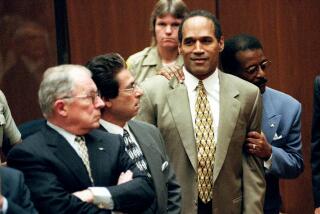Stereotype Leads Down False Trail in the Sniper Case
- Share via
Many a black comedian has perversely joked that blacks may kill each other, but they don’t shoot up, blow up or hack up crowds. This bit of gallows humor always gets a laugh from black audiences.
For decades, blacks took morbid pride and comfort in the notion that despite their long, tortured history, mass killing supposedly was a white-folks thing.
For the record:
12:00 a.m. Nov. 7, 2002 For The Record
Los Angeles Times Thursday November 07, 2002 Home Edition California Part B Page 27 Editorial Pages Desk 1 inches; 41 words Type of Material: Correction
Wayne Williams -- An Oct. 29 commentary on the profiling of the Beltway sniper misstated Williams’ 1982 murder convictions. Although accused of being a mass murderer of children and teenagers, he was convicted only of killing two adults.
The assumption was that all serial killers were young, whacked-out white males. It is easy to believe. In the rash of Hollywood slasher, horror and thrill-kill movies, serial killers are routinely depicted as deranged white males. The obsessive media attention on serial killers such as “Son of Sam” David Berkowitz, Ted Bundy, John Wayne Gacy and the Unabomber also reinforce the notion that serial killers are loopy white guys. The horde of police, profiling experts and psychologists that paraded across the TV screen during the sniper ordeal speculating on the killer also bought into this racial stereotype.
If, as it is charged, John Allen Muhammad, 41, along with teenager Lee Boyd Malvo, gunned down a dozen people and terrorized the Washington, D.C., area, then it would seem that the experts all were embarrassingly wrong in their assumptions and the old profiles and theories about mass killers deserve to be scrapped -- and, in fact, they should be. Muhammad, if guilty, is not a total aberration.
Two studies that specifically looked at the race of serial killers found that blacks made up about 15% of America’s rogue’s gallery of mass murderers. Their rampages still strike fear and disgust in the communities they pillaged.
During the 1980s, Wayne Williams was convicted of killing five children in Atlanta, and authorities think he may have killed even more. In Texas, Coral Watts claimed that he killed 13 women in several states. In the early 1990s, Cleophus Prince Jr. stabbed six women in San Diego, and authorities in East St. Louis strongly suspect a black man is behind a string of unsolved killings of prostitutes in the area.
The victims of black serial killers almost always are other blacks, who most often live in the poorest inner-city neighborhoods, where the murder rates are far higher than in middle-class suburbs. Because black-on-black crime is so entrenched, it is far too often considered routine, and police are often more lax toward the violence than if the victims were white. This makes it easier for black serial murders to go undetected for far longer.
The implicit message is that black lives are expendable. This perceived devaluation of black lives has encouraged disrespect for the law and has forced many blacks to internalize anger and displace aggression onto other blacks.
That’s important to understand because those young blacks who commit random destructive acts still are savvy enough to target victims who pose no real physical or personal threat to them.
The sniper’s victims fit that profile. The victims, although racially diverse, posed no danger to the sniper and were apparently chosen at random.
In the immediate weeks before Muhammad’s alleged run of terror, there were disturbing signs that other blacks driven by rage, bitterness and frustration were more willing than ever to wreak random violence on themselves and others.
In September, a pack of young -- one as young as 10 years old -- and not-so-young black males mauled a hapless man in Milwaukee. In June, another mob of young blacks grabbed national headlines when they stomped to death two men in Chicago. The Milwaukee and Chicago victims were low- income, middle-aged men or had alcohol and drug problems. They were easy pickings, just as the sniper’s victims were.
Though it’s not yet known what drove the person or persons responsible for the Washington-area sniper shootings, the suspect, Muhammad, is said to be a man consumed by personal rage and frustration over failed marriages, tangled personal relationships, sour business dealings and a rocky military career.
These personal demons -- and not terrorist ties, which authorities have as yet found no evidence of -- may well have been enough to push him to monstrous acts.
But equally ominous, his alleged deeds showed that it was a perilously short step from the random violence that all too often claims innocent lives and paralyzes many poor inner-city black neighborhoods to random violence that paralyzes whole cities, even a nation.
That’s a terrible price to pay for ignoring homegrown walking time bombs created by our inner cities’ festering inequities but overlooked until the madness breaks out of its racially pigeonholed boundaries.
More to Read
Sign up for Essential California
The most important California stories and recommendations in your inbox every morning.
You may occasionally receive promotional content from the Los Angeles Times.













